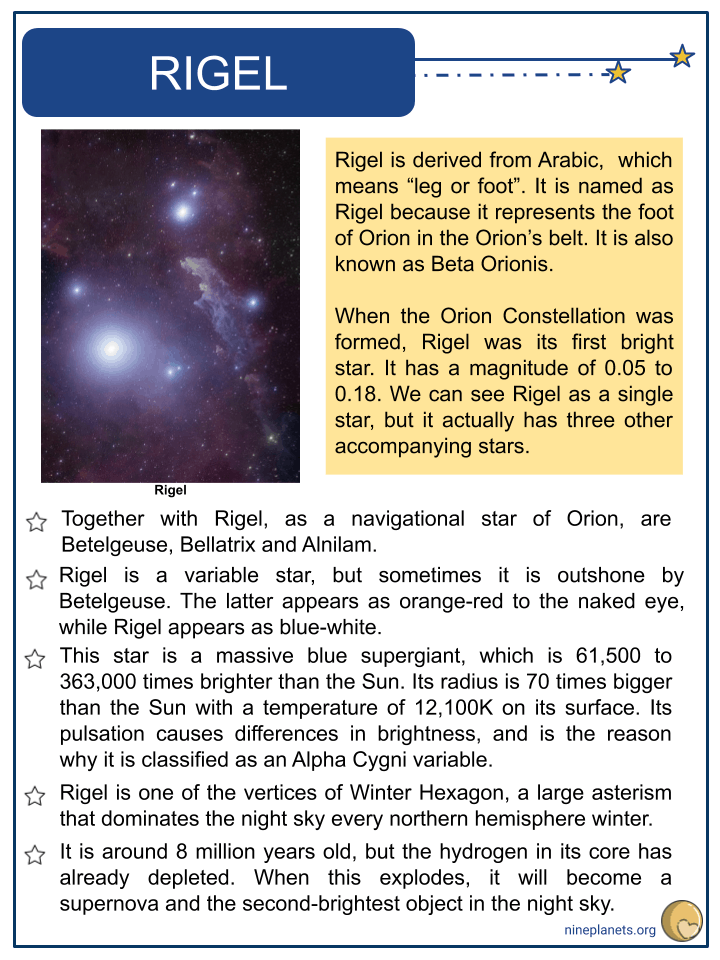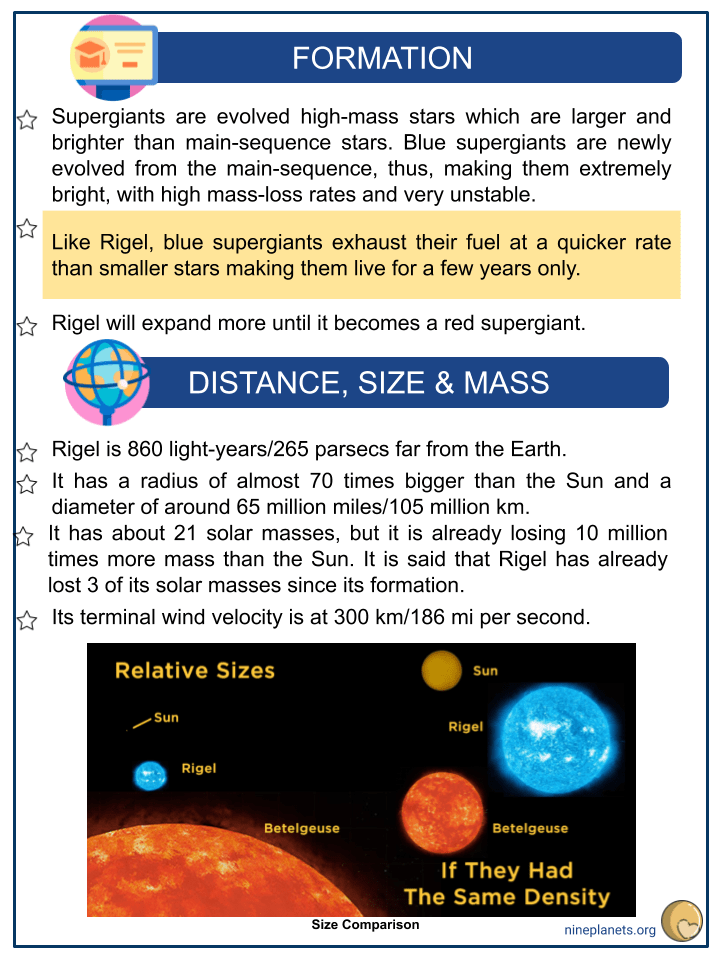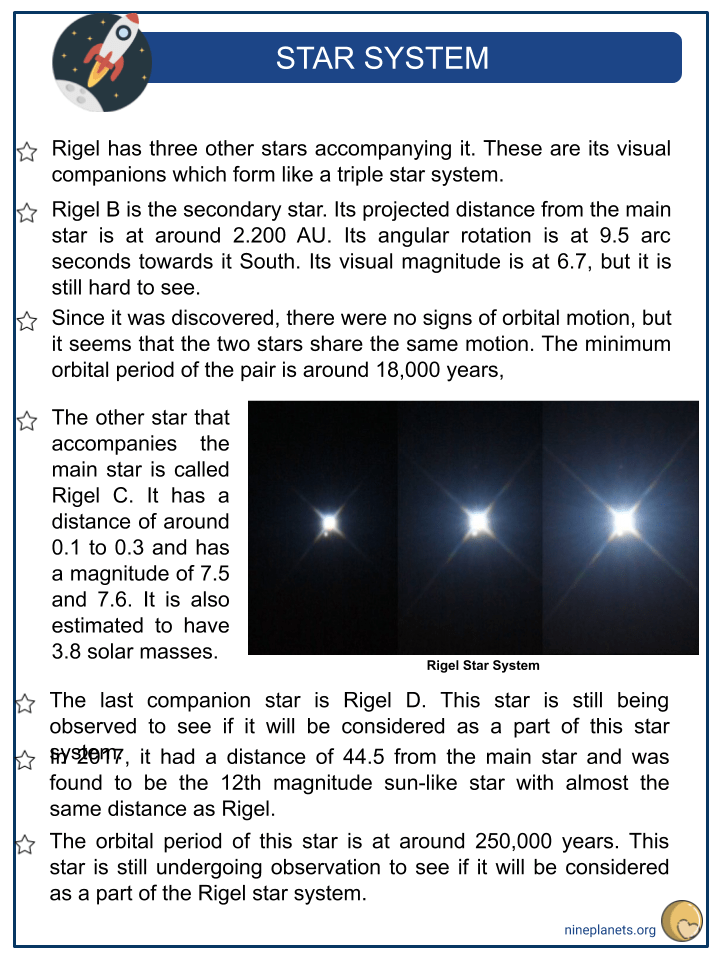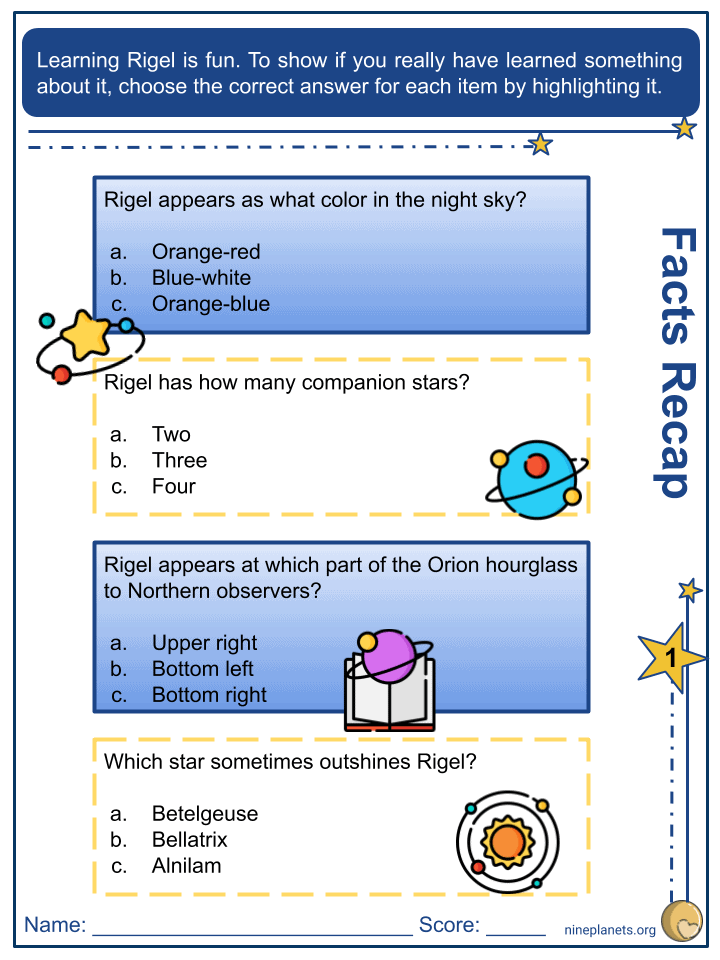Download Rigel (ẞ Orionis) Worksheets
Click the button below to get instant access to these premium worksheets for use in the classroom or at a home.

This worksheet can be edited by Premium members using the free Google Slides online software. Click the Edit button above to get started.
Download free sample
Not ready to purchase a subscription yet? Click here to download a FREE sample of this worksheet pack.
Resource Examples
Click any of the example images below to view a larger version.




Key Facts & Information
- Rigel is derived from Arabic, which means “leg or foot”. It is named as Rigel because it represents the foot of Orion in the Orion’s belt. It is also known as Beta Orionis.
- When the Orion Constellation was formed, Rigel was its first bright star. It has a magnitude of 0.05 to 0.18. We can see Rigel as a single star, but it actually has three other accompanying stars.
- Together with Rigel, as a navigational star of Orion, are Betelgeuse, Bellatrix and Alnilam.
- Rigel is a variable star, but sometimes it is outshone by Betelgeuse. The latter appears as orange-red to the naked eye, while Rigel appears as blue-white.
- This star is a massive blue supergiant, which is 61,500 to 363,000 times brighter than the Sun. Its radius is 70 times bigger than the Sun with a temperature of 12,100K on its surface. Its pulsation causes differences in brightness, and is the reason why it is classified as an Alpha Cygni variable.
- Rigel is one of the vertices of Winter Hexagon, a large asterism that dominates the night sky every northern hemisphere winter.
- It is around 8 million years old, but the hydrogen in its core has already depleted. When this explodes, it will become a supernova and the second-brightest object in the night sky.
Formation
- Supergiants are evolved high-mass stars which are larger and brighter than main-sequence stars. Blue supergiants are newly evolved from the main-sequence, thus, making them extremely bright, with high mass-loss rates and very unstable.
- Like Rigel, blue supergiants exhaust their fuel at a quicker rate than smaller stars making them live for a few years only.
- Rigel will expand more until it becomes a red supergiant.
Distance, Size & Mass
- Rigel is 860 light-years/265 parsecs far from the Earth.
- It has a radius of almost 70 times bigger than the Sun and a diameter of around 65 million miles/105 million km.
- It has about 21 solar masses, but it is already losing 10 million times more mass than the Sun. It is said that Rigel has already lost 3 of its solar masses since its formation.
- Its terminal wind velocity is at 300 km/186 mi per second.
Star System
- Rigel has three other stars accompanying it. These are its visual companions which form like a triple star system.
- Rigel B is the secondary star. Its projected distance from the main star is at around 2.200 AU. Its angular rotation is at 9.5 arc seconds towards it South. Its visual magnitude is at 6.7, but it is still hard to see.
- Since it was discovered, there were no signs of orbital motion, but it seems that the two stars share the same motion. The minimum orbital period of the pair is around 18,000 years.
- The other star that accompanies the main star is called Rigel C. It has a distance of around 0.1 to 0.3 and has a magnitude of 7.5 and 7.6. It is also estimated to have 3.8 solar masses.
- The last companion star is Rigel D. This star is still being observed to see if it will be considered as a part of this star system.
- In 2017, it had a distance of 44.5 from the main star and was found to be the 12th magnitude sun-like star with almost the same distance as Rigel.
- The orbital period of this star is at around 250,000 years. This star is still undergoing observation to see if it will be considered as a part of the Rigel star system.
Location
- Rigel is located at the left foot of Orion. It appears to be the bottom right star of the Orion’s hourglass to those observing from the North, and top left for the Southern observers.
The Future
- In the far future, Rigel will soon explode as a supernova.This will make Rigel the second-brightest star in the night sky for several weeks. After this, it can either be a neutron star or a black hole.
Did You Know?
- The earliest written mention of Rigel was in the Alfonsine Table of 1521, but its name dates back to the 10th century.
- Chinese people refer to Rigel as the Seventh Star of Three Stars, based on the Chinese three stars asterism.
- People from Lacandon in Mexico call Rigel “tunsel” which means “little woodpecker”.
- It is known as “Puanga” by the Maori people of New Zealand. Puanga is the daughter of Rehua who is the chief of all stars and is represented by Antares.
- A clan in Japan called Genji chose Rigel as their symbol, while a rival clan named Taira chose Betelgeuse. The two clans faced each other during the Genpei war. During this war, Rigel and Betelgeuse can be seen facing off each other in the night sky.
- We would all be exterminated if Rigel replaces the Sun because it is at least two times hotter.